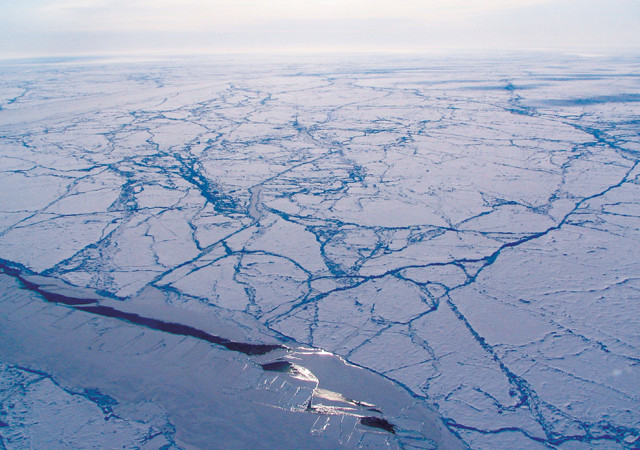
by Mary Caperton Morton Thursday, September 14, 2017

During the Eocene, the Arctic Ocean was a giant freshwater lake fed by rivers and ice melt. Today, it's salty and ice-covered much of the year. Credit: NASA.
The Arctic Ocean hasn’t always been as salty as other oceans. In the Eocene, between 56 million and 34 million years ago, the water surrounding the North Pole — freshened by melt from sea ice and river runoff — was cut off from the Atlantic and Pacific oceans by land bridges. At some point, plate tectonic processes opened the North Atlantic, submerging the land bridges and allowing saltwater to pour into the Arctic, but the timing and details of these events are largely unknown. New research suggests a tipping point may have been reached as one particular land bridge submerged far enough below the ocean surface.
In 2004, deep-ocean drilling by the International Ocean Discovery Program near the North Pole unearthed sediments containing fossils of freshwater algae dating to the Eocene. This was the first hard evidence that the Arctic Ocean was once filled with freshwater. Establishing the timeline of events that led to the Arctic’s modern connections with the North Atlantic has long proved elusive, however, due in part to a lack of indicator fossils, says Michael Stärz, a climate scientist at the Helmholtz Center for Polar and Marine Research in Germany and lead author of the new study in Nature Communications. “We have almost no direct evidence from this time period. As far as we know, [the Arctic’s switch to saltwater] could have occurred anytime between 55 million and 10 million years ago.”
To study the salinization process, Stärz and his colleagues developed a climate model to test how submersion of a former land bridge known as the Greenland Scotland Ridge would have affected circulation between the North Atlantic and Arctic oceans. The Greenland Scotland Ridge is a wall of basalt that stretches across the North Atlantic between the namesake landmasses, with Iceland in the middle. In modern times, only Iceland and a few smaller islands remain above the ocean surface while the rest of the ridge is submerged at least 500 meters.
By incrementally submerging this ridge in their model, the team found that the greatest changes in circulation patterns between the North Atlantic and the Arctic would have occurred once the Greenland Scotland Ridge was submerged to a depth of 50 meters. This threshold matches the thickness of the wind-mixed layer, in which surface waters are readily mixed by wind currents, facilitating mixing between the basins, Stärz says. Once this gateway between the North Atlantic and Arctic was deep enough, an unrestricted flow of denser saltwater would have displaced the freshwater, turning the Arctic Ocean saline in a geologic blink. The event would have had far-reaching consequences, Stärz says, affecting oceanic and atmospheric circulation patterns, heat transport from the mid-latitudes to the poles, as well as the freshwater-adapted organisms living in the Arctic.
When this switch happened is an open question, Stärz says. This study provides the “critical gateway depths for the paleoceanographic events, which helps geologists focus further research on the depth regime,” he says. “Ongoing efforts to retrieve better geophysical and geological data should help provide a better timeline still,” he adds.
“Whether this switch took decades or a century or a thousand years, we still don’t know. That may be a question to be addressed by the next drilling project,” says James Wright, a paleoceanographer at Rutgers University who was not involved in the new research. “The study does a nice job of establishing the boundary conditions for where we need to collect more data. The next drilling phase can use this critical depth to target drilling in places that might tell us more about when this mixing took place.”
© 2008-2021. All rights reserved. Any copying, redistribution or retransmission of any of the contents of this service without the expressed written permission of the American Geosciences Institute is expressly prohibited. Click here for all copyright requests.